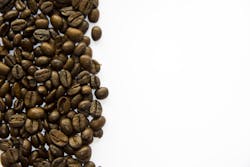Coffee Consumption Increases As Market Hits 14-Month High
Prices rallied significantly in June, as the Brazilian real strengthened against the US dollar and the 2016/17 Brazilian crop entered its potential frost season, according to the International Coffee Organization (ICO). The monthly average of the ICO composite indicator price reached a 14-month high of 127.05 cents/lb, up 6% on May, with export volumes in May also slowing for the second consecutive month. Global coffee consumption continues to increase, albeit at a slightly slower rate, with the most dynamic demand recorded in Asia & Oceania.
The daily price of the ICO composite indicator increased steadily over the course of the month, starting from a low of 118.53 US cents/lb on 1 June and ending on a high of 132.04, its highest daily level since April 2015. These developments have been matched closely by movements in the exchange rate between the Brazilian real, which also hit its strongest level against the US dollar since July 2015. This will reduce the incentive for exporters in Brazil to release coffee to the international market, especially with domestic stocks suspected to be running low. The market has also been reacting to the possibility of frost in Brazil, although any damage seems to have been relatively limited.
The four group indicators all increased compared to last month, with the most significant changes recorded in the Arabica groups. Colombian Milds, Other Milds and Brazilian Naturals settled up 8.6%, 6.6% and 7.2% respectively. Robustas, on the other hand, increased by 2.4%. As a result, the arbitrage between Arabica and Robusta, as measured on the New York and London futures markets, increased by 20.4% to 62.23 cents, also its widest level since April last year.
Total exports in May 2016 were slightly lower than last year on 9.3 million bags, the second consecutive month of reduced volumes. Nevertheless, total exports for the first 8 months of coffee year 2015/16 (October to May) are up 1.6% to reach a record 75.9 million bags, exceeding the previous high in 2012/13.
Our second estimate of world consumption in calendar year 2015 is maintained at 152.1 million bags, with a slight downward revision in importing countries compensated by an equal increase in exporting. This volume is up 1.3% compared to the previous year, representing an average annual growth rate of 2% since 2012.
The strongest growth in recent years has been recorded in Asia & Oceania, at an average rate of 5.2%, well above the global average. This growth has come from both producing countries, such as Indonesia, Vietnam and India, as well as importing countries like Turkey and Japan, all of whom continue to exhibit dynamic domestic markets.
North America has also shown relatively strong growth of 2.8% in the last four years, adding 2.2 million bags of new demand in the time period. According to the US National Coffee Association’s Coffee Drinking Trends Survey, much of this growth has been driven by an increasing preference for espresso-based gourmet drinks from younger consumers.
Consumption growth in Europe has been more modest, at an average rate of 0.4%, the same rate as South America, while Central America & Mexico is on 0.6%. Total demand in the EU is revised down slightly to 41.6 million bags, while in Brazil, the world’s second largest consuming country after the USA, demand is maintained at 20.5 million bags, although the Brazilian Coffee Industry Association (ABIC) has suggested that domestic consumption could increase during the current 2016/17 harvest.
Finally, coffee consumption in Africa has exceeded the global trend, at an average rate of 2.6%. Much of this growth has come from countries such as Ethiopia, where coffee drinking has a long domestic tradition. It is also anecdotally growing in developing countries such as Kenya and Tanzania, driven in large part by the increased popularity of coffee shops in urban areas, although this has yet to be reflected in the data.
To conclude, while the growth rate in coffee consumption has slowed slightly, this still represents 8.7 million bags of new demand over the last four years, with indications that there is plenty of potential for further growth in the future.
